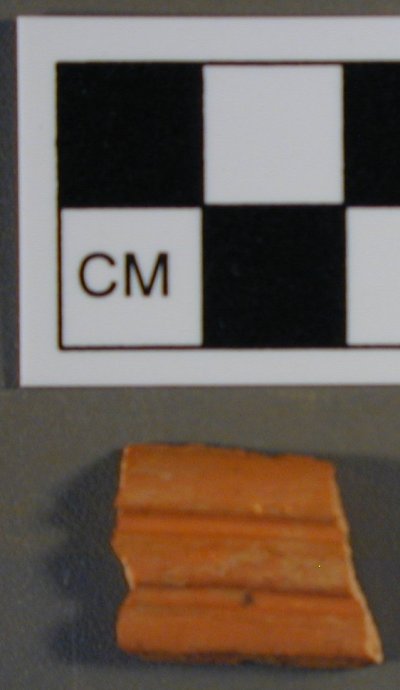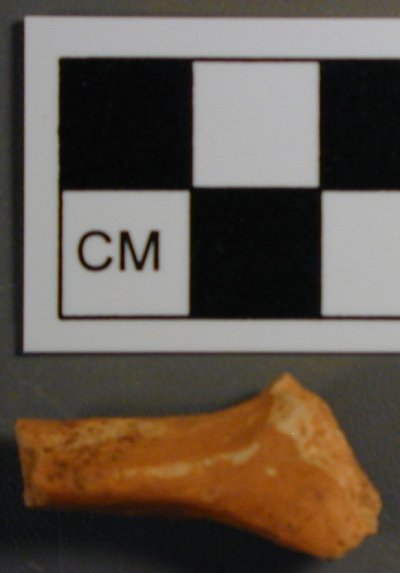Relevant history of the property
The history of Hillsborough�s Lot 41 is typical of many older Orange County properties: its ownership is somewhat difficult to trace, it was subdivided and reassembled a few times as it changed hands, and its earliest property deeds no longer exist. The lot seems to have been originally owned by Paul Harmon in the early 1760s (likely after purchasing it from William Churton in the late 1750s). Harmon operated a tan yard on the eastern side of the lot and also on Lots 42 and 43. In August 1764, Harmon apparently sold the lot to Edmund Fanning. The October 1768 map of Hillsborough by Claude J. Sauthier shows a dwelling and an outbuilding at the site.

Excerpt of Sauthier's 1768 map of Hillsborough (site outlined in red)
William Johnston purchased the lot in May 1775; in 1780, he willed his entire estate (including Lot 41) to his only child, daughter Amelia. In 1806, Amelia and her husband Walter Alves sold Lot 41 to their son, Gavin Alves. By the 1830s, after Gavin Alves's death, Lot 41 was again sold. Later owners included Sally Thompson, Stephen Moore, and Thomas Flint in the 1830s, and Levi McCollum and Cadwallader Jones, Jr. in the 1850s.
Archaeology of the site
In 2006, Orange County's Environmental and Resource Conservation Department contracted for an archaeological survey and testing to be conducted in advance of the majority of the site being destroyed by construction of the new Justice Center (the extension of the 1950s Orange County courthouse).
During the testing phase, pottery kiln furniture (utilitarian pottery pieces used in the production of pottery) was discovered. Further excavation (in 2007) uncovered a firebox for a pottery kiln, with burn marks typical of a Cassel-style pottery kiln, similar to the late eighteenth/early nineteenth century (Moravian) Christ-Krause/Krause-Butner kiln located in Bethabara, North Carolina (partially excavated in 1966, and fully excavated in 1973-1974).

Partially excavated pottery kiln firebox, showing burn marks on floor

Cassel pottery kiln
The artifacts recovered indicate a pottery production date of sometime between the 1750s and the early 1800s. All artifacts (whether kiln furniture or pottery fragments) were earthenware (a.k.a. �redware�).





Pottery production artifacts/"kiln furniture" (click to enlarge)
Dating the site
The most likely scenario is that the foundation that was uncovered during the excavation belonged to a dwelling constructed after the kiln was no longer in use. The house appears on the 1768 map of Hillsborough, and the same house was occupied until at least circa 1920 � and likely into the 1940s � based on the archaeology and historic maps.
The kiln was likely disassembled at some point, according to what was located during its partial excavation; however, until additional archaeological excavation is conducted, what exactly happened to the kiln can not be known.
Was the site utilized by Paul Harmon (or an employee or renter of Harmon's) prior to 1764? With the tannery operating on the adjacent property, perhaps the kiln was part of an "industrial complex" of sorts. Or, although not as likely, perhaps Edmund Fanning rented the property out to a potter (if he even owned the property at all). William Johnston (from 1775-1780) and Walter or Gavin Alves (from 1806-1833) were merchants and could have had pottery produced for �export� to Charleston or other market locations. And, what later owners Stephen Moore, Thomas Flint, or Levi McCollum did for a living hasn�t been sufficiently researched. And, anyone could have leased the property from any of the owners at any time without it being documented.
Potential potters
A John Bullock was a potter in Orange County circa 1798, and apprenticed an African American named Moses Newby to learn the trade. However, it seems that they lived in southwestern Orange County, in present-day Alamance County (Alamance County was formed in 1771).
Orange County tax records from 1753-54 indicate that a Peter and Thomas Craven lived in Orange County, and research conducted by Steve Compton indicates that post-circa 1763, the Cravens lived in the vicinity of present-day Person County (which was Orange County until 1778), prior to their moving to Randolph County; they may have been the potters that operated the pottery and kiln in Hillsborough, as their family were well-known potters in the 19th century.
It is most likely that the pottery was in operation sometime between 1754 and 1768, based partly on the type of kiln discovered, the style of pottery made, the type of kiln furniture discovered, and the existence of the house at the location from circa 1768 to the 1940s based on the archaeology and as depicted on historic maps and described in property records.
If it wasn't the Cravens, the potter may be listed on one of the early Orange County tax lists, but since occupations weren�t listed (and if he was a slave or perhaps even a poor white, his name was most likely not listed at all), we may never know who he was.
For now, the remaining section of the site is "protected"; perhaps one day additional archaeological excavation will shed light on a more accurate date for the pottery kiln, who the potter was, and other useful information that will add to the history of the county's � and state's � pottery production.
|
Sources:
Linda Carnes-McNaughton, personal communication.
Clauser, John W. The Excavations of the Bethabara Pottery Kiln: An Analysis of Nineteenth Century Potting Techniques. Unpublished Master's Thesis, University of Florida, Gainsville.
Steve Compton, personal communication.
Legacy Research Associates. Cultural and Archaeological Investigations for the Proposed Justice Facility Expansion in Hillsborough, Orange County, North Carolina. Report for the Orange County Environmental and Resource Conservation Department, 2007.
Orange County Register of Deeds
Deed Book 12, Page 205
Deed Book 20, Pages 137-138
Deed Book 25, Page 362
Deed Book 27, Pages 140, 484
Deed Book 34, Pages 108, 360, 402
Deed Book 37, Page 398
Deed Book 64, Page 536
Deed Book 67, Pages 322, 407
Orange County Tax List, 1753-1754.
Hal Pugh, personal communication.
Rhodes, Daniel. Kilns: Design, Construction, and Operation. Chilton Book Company, Radnor, Pennsylvania, 1968.
South, Stanley A. An Archaeological Evolution. New York: Springer Publishing. 2005.
Photographs courtesy of the Environmental and Resource Conservation Department.
|